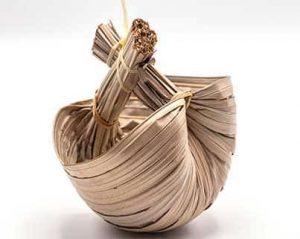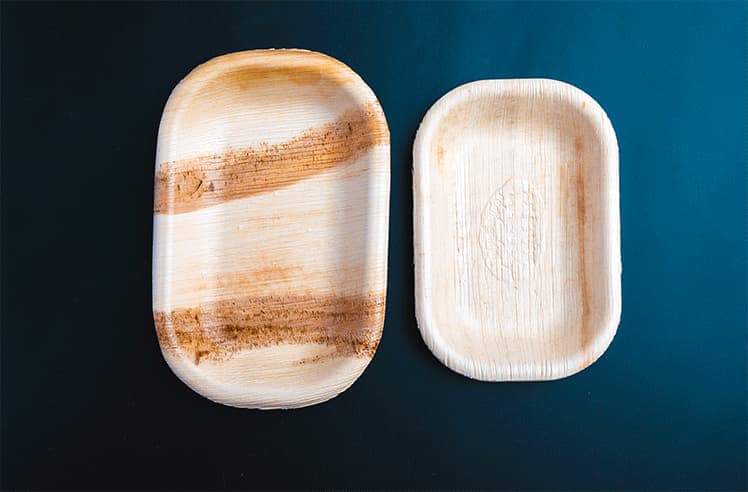Plastics may offer us quick and easy solutions to many of our problems, but in truth, they are killing our nature and our planet. A glaring proof of this is the frequent news of whales being found dead from a belly full of plastics. Every year, around 100 thousand marine mammals die of plastic pollution. It is high time we find out some alternatives lest it gets too late in the future.
One of the most common uses of plastic is in one-time use plates. They are of low cost and can be a real help in outdoor gatherings as they can just be thrown away. But that is precisely the reason we should stop using them. These discarded plastic plates damage our environment and destroy the natural wild lives. Instead of the plastic dishes, areca nut palm leaf disposable bio-plates offer the same advantages, but they come with a significant advantage of being bio-degradable. Here, we make a guideline that how to make Disposable Areca Palm Leaf Plates.
Disposable Areca Palm Leaf Plates | An Introduction
Areca nut palm leaf plates are eco-friendly disposable tableware made from the fallen leaf sheaths collected from areca palm or betel palm trees. It is believed that the origin of the areca nut palm tree is in the Philippines. But they also grow naturally in parts of the tropical Pacific, Asia, and parts of East Africa. They are mostly found in India, Southern China, Taiwan, Thailand, Maldives, Malaysia, Ceylon, Cambodia, Laos, Vietnam, Indonesia, West Indies, and New Guinea.
Areca palm tree is a native tree in India, and the country is known as the largest producer of areca leaf plates. These plates made in India are exported throughout the world. They are sustainable, compostable, and chemical-free, making them an ideal eco-friendly product.
Disposable Areca Palm Leaf Plates | Advantages
‘Areca palm leaf plate’ is a perfect alternative to harmful disposable plastic dinnerware. These plates are natural, and they do not harm our environment. Besides that, this product comes with many more advantages such as-
- This areca palm leaf plate is sustainable alongside being eco-friendly. They are produced from fallen leaves of the areca palm tree, and thus no trees are cut, or leaves are pulled for their production.
- Unlike plastic plates, these plates are naturally made and chemical-free. Therefore, these plates can be used for hot foods without fearing the emission of toxic elements.
- Bio-degradable Disposable Areca Palm Leaf Plates naturally possess a rustic, elegant look and are more visually pleasing than plastic plates. Each dish, like the leaves, is unique. They are available in various shapes and sizes.
- They are light and yet very sturdy compared to paper plates. Disposable areca palm leaf plates are water and oil resistant. One can serve all kinds of food on it without fearing the plate becoming limp. It can also be used in a microwave oven to heat the food. The taste of the food won’t change either.
- Areca nut palm leaf plates are easy to dispose of as they compost in nature within two-three months after their use. It can also be used as fertilizer or fodder. As they do not emit harmful toxic gases, they can be safely burnt.
Shapes and Sizes of Areca Palm Leaf Products
Areca palm leaves are not only used in making plates, but also in making other dinnerware such as bowls, glasses, lunch trays, partition plates, and cutleries like spoons, forks, and knives. They are available in various sizes and shapes in the market. For example, the sizes for plates usually differ from 2 inches to 12 inches. The plates and bowls are available in different forms, such as – round shape, oval shape, heart shape, apple shape, square shape, rectangular shape, hexagon shape, etc. The glasses made from areca palm leaves are shaped just like paper glasses.
Disposable Areca Palm Leaf Plates | Manufacturing Requirements
Making areca palm leaf plates are not only helpful towards the environment but also profitable. One can help in lessening environmental pollution and creating employment opportunities. There are quite a few requirements to fulfill for making disposable areca nut palm leaf plates. One should take them into account to gain better results.
Land:
It is best to build a factory near a plantation area. In this way, it will get easier to collect fresh raw materials. If the factory is far from the plantation area, then one will need to spend extra money on transport.
Approximately five to six decimal of land is needed to accommodate a shade for storing raw materials, setting up machines, working, processing, and selling products.

Raw Materials:
The raw materials for areca palm leaf plates are naturally fallen areca tree leaves. The trees usually shed four times a year. The price for areca palm tree sheaths typically ranges from $0.027-$0.062/piece or $600-$730/ton. Each leaf can be used for making multiple products. Usually, one leaf can be used to make at least three plates of different sizes.
Machinery:
The one must-have machine for manufacturing areca leaf plates is called the ‘Areca leaf plate making machine.’ This machine comes with different shaped dies where it shapes the leaves into dinnerware using heat and pressure. There are three kinds of devices available in the market-
- Fully Automatic Machine
- Semi-Automatic Machine, and
- Manual Machine
The price of the machine starts from 670 dollars, and it increases depending on its type and die numbers.
Workers:
A shed usually requires at least three to five workers to maintain an efficient working system.
Monthly Expenditure and Profit:
The main areas for expenditure in making disposable areca palm leaf plates are mentioned in this article to further one’s understanding.
If a five die machine can produce 1000 plates in a day, then using two machines for 24 days in a month, one can produce 48000 plates. If one plate is sold at $0.067, then the selling price can go around 3180 dollars. By guessing that 2-3 plates can be made from one leaf, the factory will need approximately 20000 areca leaves. If one has an adequate method for getting the necessary water daily, then he/she can save costs in this area profit more.
On a tentative scale, the costs involved in this production are-
| Details | Quantity | Price | Amount |
| Areca Leaves | 20000 | 0.053 | 1060 |
| Rent | 1 | 135 | 135 |
| Staff | 3 | 110 | 330 |
| Electricity Charge (2 Units) | 200 | ||
| Packaging Expense | 55 | ||
| Transportation Expense | 80 | ||
| Telephone Bill | 1 | 600 | 10 |
| Petrol Expense | 1 | 1000 | 20 |
| Machine Maintenance | 1 | 2000 | 30 |
| Total Tentative Cost | $1920 | ||
| Total Tentative Plates selling price | $48000 | $3180/month | |
| So, Total Tentative Profit | =(3180 – 1920) = $1260/month |
| Monthly Expenditure and Profit) Figure Credit: Farmingreader.com |
Again, it is only an amount guessed on tentative price and cost factors. They are not wholly accurate. According to the figures, the production cost for each plate is $0.04, and the profit is about $0.026.
One of the main onetime costs is the price of the ‘areca leaf plate making hydraulic drying machine’. Usually, the price of one 5-dies machine is 4320-4650 dollars. So, one needs to spend about $9280 for installing two machines in this factory. Also, if one wishes to connect computing in the factory, then $350 needs to be added to the fixed purchase figure amount. So, to be safe, one should prepare at least 13000 dollars before venturing into areca palm leaf plate production.
Time Requirement:
The areca leaves are cleaned by water for approximately 15 to 20 minutes. Then they are dried in the shed for about 30 minutes. These two steps together with is the preparation stage, which takes about 50-0 minutes. After preparation, the raw materials are used to make disposable bio-plates. The time used for the making of the plates is only 30-40 seconds.
So, after the initial preparation of the materials, one plate can be produced per minute. If multiple dies are used together, then the production time limit gets lessened as well.
Production Procedure
The manufacturing procedure for areca palm leaf plates is quite simple. The process is sustainable as the trees regularly shed the leaves, the raw material for the plates. With the necessary capital and equipment, one can easily begin the production procedure following the step given below.
- The first step in making disposable bio-plates is gathering raw materials. The plates are made of naturally fallen areca palm tree leaves. This way, no tree leaves need to be pulled out, and no trees need to be cut. As a result, no harm is done to the tree.
- The next step is cleaning the leaves. The leaves are washed multiple times in this step. Such as, the areca palm leaves are first rinsed in the water to remove dirt. Then the leaves are soaked in a sterilizing solution, like ‘water-turmeric solution’ by hand to sterilize them. Afterward, the palm leaves may once more be washed in clean water. They are soaked in the water for approximately 15-20 minutes. Another benefit of this stage is that the leaves become more flexible by absorbing water during this process. The reason is, the leaves are likely to crack in the heat and pressure at a moisture level under 5%.
- The stage after cleaning is drying the leaves. In India, the leaves are usually dried in the shed, which takes about 30 minutes. They can also be dried using heated air via machines.
- The fourth step is pressing the areca palm leaves into the desired shapes using a heated machine. It takes the leaf 30-40 seconds to come in the form. The dies of various sizes and shapes are used to produce different types of plates and dinnerware.
- In the last stage, the produced plates are cooled and pressed together under heavyweight to firm their shapes. Then they are checked for yeast/mold to ensure their quality and sanitation. Afterward, they are packaged for selling. The bio-degradable areca palm leaf plates can be stored for up to 10-12 months.
Disposable Areca Palm Leaf Plates | Disadvantages
Nothing in the world is free from having some negative sides. Despite having many advantages, these disposable-bio-plates are not out of this order either. The main disadvantages of the ‘areca nut palm leaf plate’ are mentioned here.
- Disposable Areca Palm Leaf Plates absorb water vapors in the air and can start decomposing if stored in a humid place.
- The life-span of bio-degradable areca palm leaf plates is at its highest, 10-12 months. They are not suitable for long-time storing, even in dry places.
- Disposable areca palm leaf plates are not washable and thus not reusable. They can be reused one/two times only if dry food is served, making the plates not require washing for reuse.
- These eco-friendly plates are costlier than one-time-use plastic plates.
- Unlike high-quality disposable bio-plates, low-quality palm leaf plates may have a strong smell, which can get unpleasant for someone.
Making Bio-degradable Disposable Areca Palm Leaf Plates : Profitable or Not- Profitable?
The profit level gained from making bio-degradable Disposable Areca Palm Leaf Plates mainly depend on the location of the factory. If the factory is close to an areca tree plantation area, then the business should be quite profitable. But the situation is a little different for an urban area factory. It is to be noted that the tentative monthly expenditure figure included in this article was applicable to a factory near the tree plantation area.
Urban area factories need to consider a few more things before the establishment of the factory. Due to the location, they face some issues which the factories nearby plantation areas do not meet.
Rent:
The cost of rent is high in an urban area. A fixed amount of high rent would be included in the production cost to establish a factory in a metropolitan area. But if the place used for the factory is the owner’s own, then this will not be a problem.
Water:
The production procedure of areca palm leaf plates requires using a lot of water. If the factory is not close to a clean water source, then it will cost a lot to buy tons of water for daily use.
Electricity:
As electricity is the primary source of energy in an urban area, and the price is typically high, one should be prepared to pay a hefty amount for power.
Transport Cost:
As the trees are grown in only a select few areas, the raw materials need to be transported to the cities, and the transportation bill will become an extra cost.
Waste Management:
In rural areas, it is easy to reuse the waste of the palm leaves as fodder. One can also quickly bury or burn them. But it is not possible in the cities.
Final thoughts
Disposable Areca Palm Leaf Plates are incredibly beneficial to the environment. Now a day, many are getting conscious of environmental pollution and trying to minimize damaging the environment. Increasing demand calls for expanding production activity. Making areca palm tree disposable bio-plates can not only bring profit but also contribute to the greater good of preserving our nature and protecting our world for the future generation.





